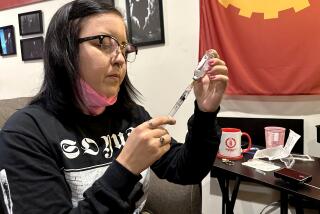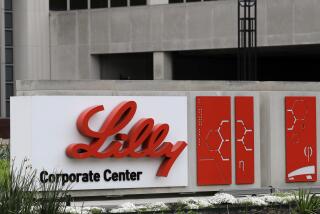Success, One Step at a Time
Alfred Mann, chairman and chief executive of MiniMed Inc., has a vision for the company he founded: to build and market an artificial pancreas that would liberate millions of insulin-using diabetics from their dependence on daily injections and frequent blood testing.
The mechanical device would be a fully automatic insulin-delivery machine, one that measures blood sugar and supplies the needed dosage of insulin around the clock. Just like the real thing.
“If you have that system, then you essentially lead a normal life,” Mann said in a recent interview in his office at MiniMed headquarters in Sylmar. “You can eat and drink what you want, when you want, and never concern yourself with how much insulin you take.”
The kind of device Mann has in mind would be revolutionary. Right now, nothing short of a pancreas transplant can do the job. Perfecting the device won’t be easy--there are plenty of technical hurdles that still have to be cleared. And approval by regulators is never a sure thing.
MiniMed already markets an insulin pump. And last month it began shipping a first-generation device for monitoring blood sugar around the clock. It’s the first such product approved by regulators and a vital step in achieving Mann’s goal, which requires hooking a sensor to a delivery system.
The world of medical devices and diabetes is a highly competitive one, and several companies would like a piece of MiniMed’s current and future business. Another California company is one of several firms racing to get their own monitoring devices on the market.
The potential rewards are high. There are an estimated 4 million insulin-using diabetics in the U.S. and 20 million worldwide. Just testing for blood sugar levels is a $3-billion-a-year global market.
That’s why MiniMed’s success does not depend solely on the company’s attaining that still-distant goal of a mechanical pancreas.
MiniMed has been profitable from the time it went public in 1995. It is built on a business plan that divides the development of an automated pancreas into smaller, achievable steps--each of which brings new products to market--and additional profits.
Sensors to measure blood sugar, external and implantable pumps for insulin and other drugs, and even a disposable pump that can be worn for several days and then discarded are all part of the mix.
MiniMed today has a market value of $2.3 billion. Mann holds more than 30% of the shares. Sales are expected to exceed $200 million this year. Product sales are up 55% for the first half of 1999, propelled by increased sales of the company’s external pump.
Analysts speak of MiniMed in superlatives. And the company’s shares have risen more than tenfold in the four years since it went public. Hambrecht & Quist analyst Robert C. Faulkner, reviewing the latest quarterly report, wrote that “MiniMed smoked our top-line estimates.” Wrote Warburg Dillon Read’s Emil Westergaard: “MiniMed reported another stellar quarter . . . as sales rocketed 55% to $49 million, 10% or $5 million ahead of our estimate.”
The company’s chief product is a programmable insulin pump for delivering varying amounts of the medication to patients around the clock. MiniMed is the world leader in pump manufacturing--85% of the 70,000 patients in the U.S. who are on the pump use a MiniMed.
Crucial to improvements in pump technology is development of a monitor that can measure glucose continuously.
The company got an endorsement from the Food and Drug Administration for its sensing device, which indirectly measures blood sugar levels. The sensors are intended for physicians, who will use them to monitor blood sugar levels in patients for up to three days to determine the dosage and timing of insulin administration, either by pump or injection.
The company is already at work on a different version that patients can wear continuously--one that will warn them when their blood sugar levels are too high or too low.
“Continuous tissue glucose monitoring is breakthrough technology that ultimately could revolutionize the care of diabetics. This new system is a first step in that direction,” FDA Commissioner Jane E. Henney said in mid-June, when the agency OKd the device.
Without the sensor, the only way for diabetics to monitor their own blood sugar levels is by pricking a finger and testing a drop of blood.
The first-generation sensing device measures glucose levels every five minutes, but it will still require several “fingersticks” a day to check the monitor’s accuracy.
A number of other companies are working on monitors that will do even better. Cygnus of Redwood City hopes to beat MiniMed to market with a sensor for patients--a wristwatch-size device that it calls the GlucoWatch. The Cygnus device does not penetrate the skin, but a piece of it--the part that directly contacts the skin--must be replaced every 12 hours, and it takes three hours of warmup time before the unit will give accurate readings.
The Cygnus product is on the FDA’s fast track for approval.
Diabetes is a widespread and still incurable disease affecting as many as 16 million Americans, according to the American Diabetes Assn.
The disease is a failure to control the movement of glucose--sugar--from the bloodstream into cells where it is converted into energy. Insulin, a natural hormone, regulates the process. Some diabetics produce little or no insulin; others produce the hormone, but their bodies become insensitive to it.
Without enough insulin, high blood sugar levels can lead to a variety of tissue damage. If totally uncontrolled, the sugar can cause coma and death.
The majority of diabetics--those who develop the disorder later in life--are able to manage the disease with diet and exercise and sometimes oral medications. But for many, the only treatment available is regular insulin injections. The advantage of a pump is that it can provide multiple injections daily in differing amounts, according to the body’s needs.
MiniMed began marketing its miniature pumps in 1983 while it was still a division of another Mann company--Pacesetter Systems, one of the leading manufacturers of cardiac pacemakers. The company was spun off as an independent company in 1985, when the pacemaker manufacturer was acquired by Munich-based Siemens.
At its Sylmar plant, MiniMed workers in blue smocks assemble 145 of the latest-model insulin pumps each day. The size and shape of a pager, each of the compact devices includes the tiny cylindrical pump itself and the microchips to run it.
The unit sends the insulin through a disposable injection system--clear, flexible tubing that ends in a device resembling a plastic insect, complete with stinger--that delivers the insulin just under the skin in the abdomen. It’s not as uncomfortable as it sounds, according to patients.
The latest model sells for about $5,000. The disposable parts must be changed every few days and can cost the patient up to $1,500 a year.
MiniMed’s competitor for pump business is Disetronic of Switzerland, which now dominates the European pump market but trails in the U.S.
The new sensor for measuring blood sugar is intended to give physicians a better idea of how their patients are doing--checking the levels every five minutes.
Patients will still have to take some blood samples to calibrate the device. But by recording measurements around the clock, doctors will know whether a patient’s blood sugar drops too low while the person is sleeping or rises too high upon awakening.
As with the insulin pumps, the glucose monitoring units are what analyst Faulkner calls “a razor-and-blade business”--with the disposable parts accounting for a significant proportion of sales.
Initially, the monitors that record sugar levels will sell for $1,475; the disposable sensors, with small probes inserted through the skin, are $29.50.
During the next year or so, MiniMed hopes to sell between 1,000 and 2,000 units to physicians, said Vice President John Mastrototaro. Each monitor would require as many as 10 disposable sensors a month, which would mean manufacturing 20,000 a month. That’s a small market, but executives believe that it will build demand for the automated pumps as physicians and patients learn the need for better control of blood sugar levels.
MiniMed’s new plant and headquarters facility, now under construction at Cal State Northridge, will be able to churn out a million disposable sensors a month, enough to supply 100,000 patients using the still-unapproved consumer version of the monitor.Eventually, the company hopes to be able to hook a sensor system to one of its external pumps to create a portable pancreas--but development of that product is several years away.
Not all of MiniMed’s undertakings have gone smoothly. The company has been working on an implantable insulin pump--one that would be inserted under a patient’s skin and refilled every few months by a physician. That project has bogged down in regulatory approval. European regulators have approved the device but not the special insulin that the pump requires. Only about 350 patients with diabetes are using it, mostly in clinical trials.
MiniMed is also working with several other companies on devices to deliver medication for diseases other than diabetes, including cancer and heart disease.
Mann gets visibly excited when he talks about the company’s cancer program, being carried out with CTL Immunotherapies, which includes a trial of a new drug for patients with advanced melanoma.
“The first three patients were expected to live a matter of weeks,” he said. “It’s now over eight months and they’re still doing fine.”
*
Editor’s note: Alfred Mann will be a keynote speaker at the Los Angeles Times Small Business Strategies Conference Sept. 24-25 at the Los Angeles Convention Center. To register or get more information, call (800) 350-3211 or go to http://ukobiw.net/sbsc.
(BEGIN TEXT OF INFOBOX / INFOGRAPHIC)
Robust Rise
MiniMed is one of several firms competing to create a fully automatic insulin machine, an artificial pancreas that would free diabetics from injecting the substance. Since it went public in 1995, the Sylmar-based company’s stock price has soared. Monthly closes and latest:
Friday: $79.50
*
Earnings per share*
1994: -$0.09
1995: $0.11
1996: $0.13
1997: $0.25
1998: $0.46
*Fully diluted
Source: MiniMed Inc.
More to Read
Inside the business of entertainment
The Wide Shot brings you news, analysis and insights on everything from streaming wars to production — and what it all means for the future.
You may occasionally receive promotional content from the Los Angeles Times.










